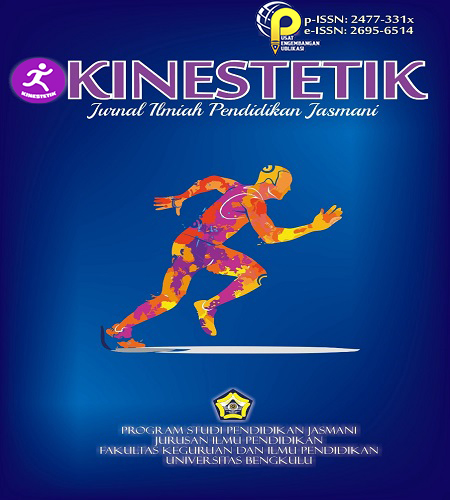Main Article Content
Abstract
Keywords
Article Details
- Authors retain copyright and grant the journal right of first publication with the work simultaneously licensed under a Creative Commons Attribution-ShareAlike 4.0 (CC BY-SA) that allows others to share the work with an acknowledgement of the work's authorship and initial publication in this journal.
- Authors are able to enter into separate, additional contractual arrangements for the non-exclusive distribution of the journal's published version of the work (e.g., post it to an institutional repository or publish it in a book), with an acknowledgement of its initial publication in this journal.
- Authors are permitted and encouraged to post their work online (e.g., in institutional repositories or on their website) prior to and during the submission process, as it can lead to productive exchanges, as well as earlier and greater citation of published work (See The Effect of Open Access).
- This work is licensed under a Creative Commons Attribution-ShareAlike 4.0 International License.
References
- Baek, J.-H., Keath, A., & Elliott, E. (2018). Physical Education Teachers’ Technology Practices and Challenges. International Journal of Human Movement Science, 12(2), 27–42. https://doi.org/10.23949/ijhms.2018.08.12.2.2
- Craig, C. L., Tudor-Locke, C., Cragg, S., & Cameron, C. (2010). Process and treatment of pedometer data collection for youth: The canadian physical activity levels among youth study. Medicine and Science in Sports and Exercise, 42(3), 430–435. https://doi.org/10.1249/MSS.0b013e3181b67544
- Enright, E., & Gard, M. (2016). Media, digital technology and learning in sport: a critical response to Hodkinson, Biesta and James. Physical Education and Sport Pedagogy. https://doi.org/10.1080/17408989.2015.1043258
- Hoyos Cillero, I., & Jago, R. (2010). Systematic review of correlates of screen-viewing among young children. Preventive Medicine, 51(1), 3–10. https://doi.org/10.1016/j.ypmed.2010.04.012
- Juniu, S. (2011). Pedagogical Uses of Technology in Physical Education. Journal of Physical Education, Recreation & Dance, 82(9), 41–49. https://doi.org/10.1080/07303084.2011.10598692
- Lloyd, M., Colley, R. C., & Tremblay, M. S. (2010). Advancing the debate on “fitness testing” for children: Perhaps we’re riding the wrong animal. Pediatric Exercise Science, 22(2), 176–182. https://doi.org/10.1123/pes.22.2.176
- McVicker, D. (2018). How technology changes Physical Education classes. G2 Learn Hub. https://learn.g2.com/technology-in-physical-education
- Mohnsen, B. (2012). Implementing Online Physical Education. Journal of Physical Education, Recreation & Dance, 83(2), 42–47. https://doi.org/10.1080/07303084.2012.10598727
- Morgan, C. F., Beighle, A., Pangrazi, R. P., & Pangrazi, D. (2004). Children ’ s Fitness Using Self-Assessment for Personal Fitness Evaluation. Teaching Elementary Physical Education, 15(1), 19–22.
- Pangrazi, R. P., & Beighle, A. (2016). Dynamic Physical Education for Elementary School Children (18th editi). Pearson Education, Inc.
- Pangrazi, R. P., Beighle, A., Shawley, J. M., Corte, M., & Nichols, C. (2020). Physical Activity and Learning: The Ingredients of a Quality Lesson. In 2020 SHAPE America National Convention & Expo. SHAPEAMERICA.
- Pereira, J., Hastie, P., Araújo, R., Farias, C., Rolim, R., & Mesquita, I. (2014). A comparative study of students’ track and field technical performance in sport education and in a direct instruction approach. Journal of Sports Science and Medicine, 14(1), 118–127.
- Wyant, J., & Baek, J. H. (2019). Re-thinking technology adoption in physical education. Curriculum Studies in Health and Physical Education, 10(1), 3–17. https://doi.org/10.1080/25742981.2018.1514983
- Yildiz, Ö. (2013). Physical education teachers’ performance evaluation. Life Science Journal, 10(1), 796–803. https://doi.org/10.7537/marslsj100113.125
References
Baek, J.-H., Keath, A., & Elliott, E. (2018). Physical Education Teachers’ Technology Practices and Challenges. International Journal of Human Movement Science, 12(2), 27–42. https://doi.org/10.23949/ijhms.2018.08.12.2.2
Craig, C. L., Tudor-Locke, C., Cragg, S., & Cameron, C. (2010). Process and treatment of pedometer data collection for youth: The canadian physical activity levels among youth study. Medicine and Science in Sports and Exercise, 42(3), 430–435. https://doi.org/10.1249/MSS.0b013e3181b67544
Enright, E., & Gard, M. (2016). Media, digital technology and learning in sport: a critical response to Hodkinson, Biesta and James. Physical Education and Sport Pedagogy. https://doi.org/10.1080/17408989.2015.1043258
Hoyos Cillero, I., & Jago, R. (2010). Systematic review of correlates of screen-viewing among young children. Preventive Medicine, 51(1), 3–10. https://doi.org/10.1016/j.ypmed.2010.04.012
Juniu, S. (2011). Pedagogical Uses of Technology in Physical Education. Journal of Physical Education, Recreation & Dance, 82(9), 41–49. https://doi.org/10.1080/07303084.2011.10598692
Lloyd, M., Colley, R. C., & Tremblay, M. S. (2010). Advancing the debate on “fitness testing” for children: Perhaps we’re riding the wrong animal. Pediatric Exercise Science, 22(2), 176–182. https://doi.org/10.1123/pes.22.2.176
McVicker, D. (2018). How technology changes Physical Education classes. G2 Learn Hub. https://learn.g2.com/technology-in-physical-education
Mohnsen, B. (2012). Implementing Online Physical Education. Journal of Physical Education, Recreation & Dance, 83(2), 42–47. https://doi.org/10.1080/07303084.2012.10598727
Morgan, C. F., Beighle, A., Pangrazi, R. P., & Pangrazi, D. (2004). Children ’ s Fitness Using Self-Assessment for Personal Fitness Evaluation. Teaching Elementary Physical Education, 15(1), 19–22.
Pangrazi, R. P., & Beighle, A. (2016). Dynamic Physical Education for Elementary School Children (18th editi). Pearson Education, Inc.
Pangrazi, R. P., Beighle, A., Shawley, J. M., Corte, M., & Nichols, C. (2020). Physical Activity and Learning: The Ingredients of a Quality Lesson. In 2020 SHAPE America National Convention & Expo. SHAPEAMERICA.
Pereira, J., Hastie, P., Araújo, R., Farias, C., Rolim, R., & Mesquita, I. (2014). A comparative study of students’ track and field technical performance in sport education and in a direct instruction approach. Journal of Sports Science and Medicine, 14(1), 118–127.
Wyant, J., & Baek, J. H. (2019). Re-thinking technology adoption in physical education. Curriculum Studies in Health and Physical Education, 10(1), 3–17. https://doi.org/10.1080/25742981.2018.1514983
Yildiz, Ö. (2013). Physical education teachers’ performance evaluation. Life Science Journal, 10(1), 796–803. https://doi.org/10.7537/marslsj100113.125
